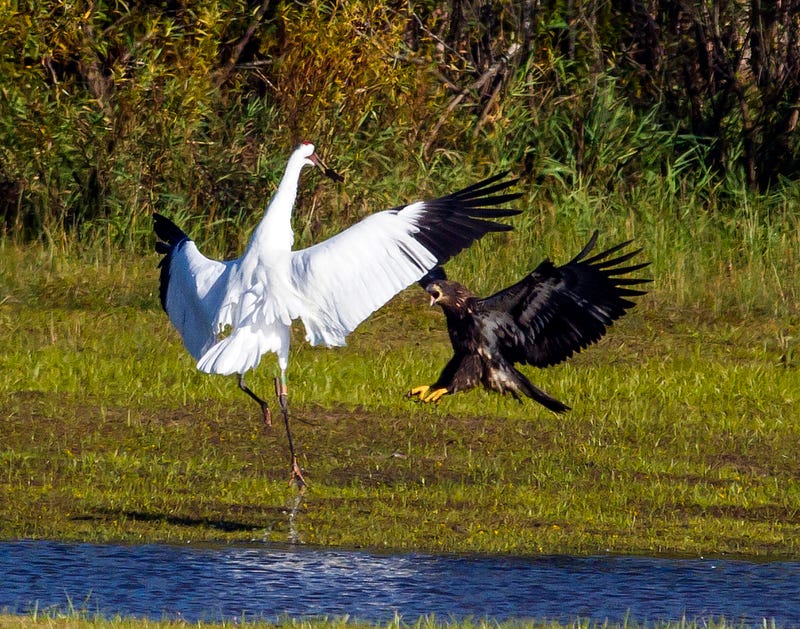
While evolution via natural selection is sometimes referred to as ‘survival of the fittest’, this is not good nomenclature for the layperson. The terms ‘fittest’ and ‘fitness’ have cultural meaning for us beyond what is intended in a biological context. Evolution does not have an end goal. It is not directed, but simply an explanation of observed facts. This includes the fact that ‘survival of the fittest’ could easily be rephrased as ‘survival of the good enough for now’. Small changes can cause fluctuations in survival and reproductive success. Sometimes, saving just a little bit more energy is all that it takes. Of course, this means that a variety of species have developed methods for obtaining nutrition without going through the hard work normally required. Instead, they resort to theft.
An organism stealing food from another is referred to as kleptoparasitism (klepto coming from the ancient Greek words for ‘thief’ and ‘steal'). Usually, it occurs as an energy-saving strategy and can be employed against other species, allowing the thief potential access to prey it might not be able to obtain itself, or other individuals of ones own species, taking advantage of the hard work of others and reaping the benefits. The gull pictured above, is not able to dive like the smaller tern, so it uses its larger size in an attempt to get an easy meal.
Many kleptoparasites are opportunistic, meaning that they can and will catch their own prey, but will resort to theft if an easy opportunity arises. This is especially evident in one of the more iconic species of North America, the bald eagle, Haliaeetus leucocephalus. One of the largest species of raptors on that continent, its diet is primarily fish, though it will also consume smaller birds and mammals as well. While it can catch its own prey, it is well known for being a scavenger and a thief. Their size allows them to intimidate and steal from other fish-eaters such as the osprey, Pandion haliaetus. However, the juvenile individual pictured below (note that the white head and tail plumage has yet to grow in) has picked a fight with an adult whooping crane, Grus americana, not a great idea.

Injury from the potential victim is one of the most common potential pitfalls of kleptoparasitism. Contrary to certain popular television shows, most animals will not prefer to fight and two species not in a predator/prey relationship will rarely fight to the death. The reason for this is that even the victor in such a battle is liable to receive devastating injuries. Even non-fatal injuries can lead to potential death from infection and sepsis or be crippling. Damage to a wing preventing flight is usually a death sentence for a bird, for example, as it will not be able to escape from predators or forage for itself.
Birds are not the only kleptoparasites, either. Various mammalian predators will steal a kill from each other if they possess superior size or numbers. Some species will even both parasitize off of each other in different circumstances. For example, the spotted hyena, Crocuta crocuta, and the lion, Panthera leo, in Africa can both kill their own prey, but will gladly steal the catch of another predator if able. However, not all kleptoparasites accomplish their goals by being bigger or stronger. Invertebrate species, like the one pictured below, can instead get by being small and inconspicuous.

This is a red and silver dewdrop spider, Argyrodes flavescens, a species native to Southeast Asia. While it (and all other members of its genus) can spin their own webs, they prefer to reside on the webs of larger spiders and feed on the trapped prey of the host individual. Some fly species will also visit spider webs and feed on half-eaten stink bugs. The water cricket, Velia caprai, will parasitize larger prey items acquired by other members of its species. Some genera of dung beetles will not transport their own vertebrate dung, but instead use the dung acquired by others.
In the end, it is important not to ascribe human customs and morality to the actions of kleptoparasites. While such a method of obtaining food might seem underhanded to us, keep in mind that these behaviors developed because they worked. Being able to steal from another species (or a weaker member of your own) is a way to potentially save energy on foraging, giving you a survival advantage. You might then ask, ‘If that’s so, why isn’t such behavior more widely seen in humans?’. This is an excellent question. As primates, we are highly social animals. Theft would have been discouraged in our earlier development through shunning behavior against perpetrators. Being removed from the social group would have a net negative impact on the thief’s survival and reproduction.
Season 5 is drawing to a close. Next week is the grand finale. I hope you have enjoyed this particular topic as much as I have. Were there any particular bits of information that really captivated you? Let me know which story this season was your favorite and why and, as always, please share these with others you think might enjoy them.